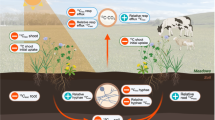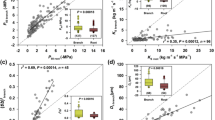Summary
Encelia farinosa and Encelia frutescens are drought-decidous shrubs whose distributions overlap throughout much of the Sonoran Desert. During hot and dry periods, leaves of E. farinosa utilize increased leaf reflectance to reduce leaf temperature, whereas leaves of E. frutescens have substantially higher leaf conductances and rely on increased transpirational cooling to reduce leaf temperature. E. farinosa is common on the dry slope microhabitats, whereas E. frutescens occurs only in wash microhabitats where greater soil moisture is available to provide the water necessary for transpirational cooling. E. farinosa tends not to persist in wash microhabitats because of its greater susceptibility to flashfloods. The consequences and significance of increased leaf reflectance versus increased transpirational cooling to leaf temperature regulation are discussed.
Similar content being viewed by others
References
Althawadi AM (1985) The leaf energy balance of a desert plant Citrullus colocynthis (L.) Schrad, with special reference to water economy. Ph D Thesis, University of Edinburgh
Althawadi AM, Grace J (1986) Water use by the desert cucurbit Citrullus colocynthis (L.) Schrad. Oecologia (Berlin) 70:475–480
Billings WD, Morris RJ (1951) Reflection of visible and infrared radiation from leaves of different ecological groups. Am J Bot 38:327–331
Comstock, JP, Ehleringer JR (1984) Photosynthetic responses to slowly decreasing leaf water potentials in Encelia frutescens. Oecologia (Berlin) 61:241–248
Comstock J, Ehleringer JR (1986) Canopy dynamics and carbon gain in response to soil water availability in Encelia frutescens Gray, a drought-decidous shrub. Oecologia (Berlin) 68:271–278
Coulter JM, Barnes CR, Cowles HC (1991) A Text Book of Botany for Colleges and Universities. Vol. 2. Ecology. American Book New York
Cunningham GL, Strain BR (1969) An ecological significance of seasonal leaf variability in a desert shrub. Ecology 50:400–408
Ehleringer JR (1981) Leaf absorptances of Mohave and Sonoran Desert plants. Oecologia (Berlin) 49:366–370
Ehleringer JR (1982) The influence of water stress and temperature on leaf pubescence development in Encelia farinosa. Am J Bot 69:670–675
Ehleringer JR (1983) Characterization of a glabrate Encelia farinosa mutant: morphology, ecophysiology, and field observations. Oecologia (Berlin) 57:303–310
Ehleringer JR (1985) Comparative microclimatology and plant responses in Encelia species from contrasting habitats. J Arid Environ 8:45–56
Ehleringer JR (1988) Changes in leaf characteristics of species along elevational gradients in the Wasatch Front, Utah. Am J Bot (in press)
Ehleringer JR, Björkman, O (1978) A comparison of photosynthetic characteristics of Encelia species possessing glabrous and pubescent leaves. Plant Physiol 62:185–190
Ehleringer JR, Clark C (1988) Evolution and adaptation in Encelia (Asteracea). In: Gottlieb L, Jain S (eds) Plant Evolutionary Biology, Chapman and Hall, New York, (in press)
Ehleringer JR, Cook CS (1984) Photosynthesis in, Encelia farinosa Gray in response to decreasing leaf water potential Plant Physiol 75:688–693
Ehleringer JR, Cook CS (1987) Leaf hairs in Encelia. Am J Bot 74:1532–1540
Ehleringer JR, Cook CS (1988) Comparative ecophysiology of Encelia farinosa and Encelia frutescens. II. Carbon and nitrogen balance (in prep.)
Ehleringer JR, Mooney HA (1978) Leaf hairs: effects on physiologyical activity and adaptive value to a desert shrub. Oecologia (Berlin) 57: 340–351
Ehleringer JR, Werk KS (1986) Modification of solar radiation absorption patterns and the implications for carbon gain at the leaf level. In: Givnish T (ed) On the Economy of Plant Form and Function. Cambridge University Press, London, pp 57–82
Ehleringer JR, Mooney HA, Gulmon SL, Rundel PW (1981) Parallel evolution of leaf pubescence in Encelia in coastal deserts of North and South America. Oecologia (Berlin) 49:38–41
Farquhar GD, O'Leary MH, Berry JA (1982) On the relationship between carbon isotope discrimination and the intercellular carbon dioxide concentration in leaves. Aust J Plant Physiol 9:121–137
Forseth IN, Ehleringer JR (1980) Solar tracking response to drought in a desert annual. Oecologia (Berlin) 44:159–163
Gates DM (1962) Energy Exchange in the Biosphere. Harper and Row, New York
Gates DM (1980) Biophysical Ecology. Springer, New York
Hunt CB 1966 Plant ecology of Death Valley, California. United States Geological Survey Professional Paper 509
Lange OL (1959) Untersuchungen über Wärmehaushalt und Hitzeresistenz mauretanischer Wüsten-und Savannenpflanzen. Flora 147:595–651
Maximov NA (1929) The Plant in Relation to Water. Allen and Unwin, London
Mooney HA (1980) Photosynthetic plasticity of populations of Heliotropium curassavicum L. originating from differing thermal regimes. Oecologia (Berlin) 45:372–376
Nilsen ET, Sharifi MR, Rundel PW (1984) Comparative water relations of phreatophytes in the Sonoran Desert of California. Ecology 65:767–778
Nilsen ET, Sharifi MR, Rundel PW, Jarrell WM, Virginia RA (1983) Diurnal and seasonal water relations of the desert phreatophyte Proposis glandulosa (honey mesquite) in the Sonoran Desert of California. Ecology 64:1381–1393
Rashke K (1960) Heat transfer in the environment. Ann Rev Plant Physiol 11:111–126
Roy J, Mooney HA (1982) Physiological adaptation and plasticity to water stress of coastal and desert populations of Heliotropium curassavicum L. Oecologia (Berlin) 52:370–375
Shreve EB (1924) Factors governing seasonal changes in transpiration in Encelia farinosa. Bot Gaz 77:432–439
Shreve F, Wiggins IL (1964) Vegetation and Flora of the Sonoran Desert. Stanford University Press Stanford
Smith WK (1978) Temperatures of desert plants: another perspective on the adaptability of leaf size. Science 201:614–616
Smith WK, Nobel PS (1977a) Influences of seasonal changes in leaf morphology on water-use efficiency for three desert broadleaf shrubs. Ecology 58:1033–1043
Smith WK, Nobel PS (1977b) Temperature and water relations for sun and shade leaves of a desert broadleaf, Hyptis emoryi. J Exp Bot 28:169–183
Smith SD, Osmond CB (1987) Stem photosynthesis in a desert ephemeral, Eriogonum inflatum. Morphology, stomatal conductance and water-use efficiency in field populations. Oecologia (Berlin) 72:533–541
Author information
Authors and Affiliations
Rights and permissions
About this article
Cite this article
Ehleringer, J.R. Comparative ecophysiology of Encelia farinosa and Encelia frutescens . Oecologia 76, 553–561 (1988). https://doi.org/10.1007/BF00397869
Received:
Issue Date:
DOI: https://doi.org/10.1007/BF00397869




